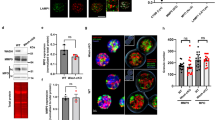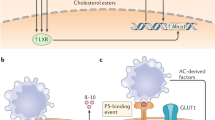Abstract
NEUTROPHIL granulocytes are the most numerous leukocytes and have a primary microbicidal role. They are the first cells to accumulate at sites of inflammation where they engulf, kill and digest microbes. The phagocytic process is accompanied by a burst of oxygen consumption which is important for the killing of certain bacteria, as the ability to kill bacteria is impaired in anaerobic conditions1; in chronic granulomatous disease (CGD) this enhancement of oxygen consumption is distinctively lacking2. The burst of oxygen metabolism is not inhibited by cyanide or azide3, distinguishing it from mitochondrial respiration by these cells which contain few mitochondria and derive most of their energy from glycolysis. The subcellular localisation and mechanism of this oxidase system have been the subject of considerable investigation and controversy. We describe here a cytochrome b system which becomes incorporated into the phagocytic vacuoles of human neutrophils. It is distinct from the cytochrome systems of the endoplasmic reticulum and mitochondria, and abnormalities in patients with CGD implicate it as an essential component of the microbicidal oxidase system.
This is a preview of subscription content, access via your institution
Access options
Subscribe to this journal
Receive 51 print issues and online access
$199.00 per year
only $3.90 per issue
Buy this article
- Purchase on Springer Link
- Instant access to full article PDF
Prices may be subject to local taxes which are calculated during checkout
Similar content being viewed by others
References
Mandell, G. L. Infect. Immun. 9, 337–341 (1974).
Quie, P. G., White, J. G., Holmes, B. & Good, R. A. J. clin. Invest. 46, 668–679 (1967).
Sbarra, A. J. & Karnovsky, M. L. J. biol. Chem. 234, 1355–1362 (1959).
Yang, C. C. & Legallais, V. Rev. scient. Instrum. 25, 801–807 (1954).
Segal, A. W. & Peters, T. J. Clin. Sci. molec. Med. 52, 429–442 (1977).
Segal, A. W. & Peters, T. J. Q. Jl Med. 47, 213–220 (1978).
Romeo, D., Zabucchi, G. & Rossi, F. in Movement, Metabolism and Bactericidal Mechanisms of Phagocytes (eds Rossi, F., Patriarca, P. L. & Romeo, D.) 153–165 (Piccin Medical Books, Padua, 1977).
Lemberg, R. & Barrett, J. Cytochromes (Academic, London, 1973).
Olsson, L., Olofsson, T. & Odeberg, H. Scand. J. Haematol. 9, 483–491 (1972).
Segal, A. W., Jones, O. T. G., Webster, D. & Allison, A. C. Lancet ii, 446–449 (1978).
Windhorst, D. B., Page, A. R., Holmes, B., Quie, P. G. & Good, R. A. J. clin. Invest. 47, 1026–1034 (1968).
Singer, J. M. & Plotz, C. M. Am. J. Med. 21, 888–892 (1956).
Kakinuma, K. & Minakami, S. Biochim. biophys. Acta 538, 50–59 (1978).
Author information
Authors and Affiliations
Rights and permissions
About this article
Cite this article
SEGAL, A., JONES, O. Novel cytochrome b system in phagocytic vacuoles of human granulocytes. Nature 276, 515–517 (1978). https://doi.org/10.1038/276515a0
Received:
Accepted:
Issue Date:
DOI: https://doi.org/10.1038/276515a0
Comments
By submitting a comment you agree to abide by our Terms and Community Guidelines. If you find something abusive or that does not comply with our terms or guidelines please flag it as inappropriate.



